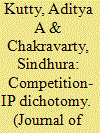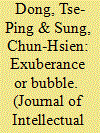|
|
|
Sort Order |
|
|
|
Items / Page
|
|
|
|
|
|
|
| Srl | Item |
| 1 |
ID:
105119


|
|
|
|
|
| Publication |
2011.
|
| Summary/Abstract |
This article aims to evaluate the potential use of collective marks and geographical indications as forms of protection for ownership and differentiation of handicraft production in Brazil, considered as intangible heritage. Although, the instruments of intellectual property are, a priori, suitable only for products with industrial application, the above instruments of IPR could be applied to traditional crafts as well. Geographical indications and collective marks are forms of intellectual property protection that are associated with reputation protection and market distinctiveness. Apparently, they could be effectively used to protect and appropriate benefits of economic exploitation in the case of craftsmanship as in Brazilian artisan products
|
|
|
|
|
|
|
|
|
|
|
|
|
|
|
|
| 2 |
ID:
105120


|
|
|
|
|
| Publication |
2011.
|
| Summary/Abstract |
Technology transfer agreements are necessary to fulfil technological needs that are impossible to meet with local technical capabilities. Traditional devices of licence transfer often fall within the purview of antitrust scrutiny and are deemed anti-competitive practices in general trade, as in the case of territorial restrictions in licensing. Antitrust laws, although fit to evaluate general trade agreements, often fail to address intricate problems involving IPR and therefore, lack the tools to adequately solve them. The blanket protection approach to IP as provided by Section 3(5) of the Indian Competition Act is equally ineffective due to lack of a mechanism to deal with IP-related unfair trade practices. The TRIPS under Article 40, permits member states to prevent abuse of IP through anti-trust legislations. India has permitted cross licensing under its patent laws but has failed to prevent its anti-competitive fallout in technology licensing. This article draws from the EU TTBE 2004 Regulations as well as the US antitrust guidelines to highlight the need for a balance between the two conflicting interests of competition policy and the protection of technological know-how. It further purports to set forth an adaptation of guidelines for India, keeping in mind the anti-trust laws of other jurisdictions.
|
|
|
|
|
|
|
|
|
|
|
|
|
|
|
|
| 3 |
ID:
105118


|
|
|
|
|
| Publication |
2011.
|
| Summary/Abstract |
In an information society, granting the Internet Service Provider (ISP) exemption from liability under certain circumstances is an important approach to strike a balance between the interests of the copyright holder, the ISP and the public. Although many countries conditionally provide safe harbour protection for online services, the certainty, feasibility and efficiency of the relevant provisions are different from one country to another. This article reviews China's approach to limitation of the ISP's liability from a perspective of legislation and judicial practice, compares differences in this context between China, the US and EU, and based on which discusses the feasible options for China to increase the certainty of law and inconsistency in judicial practice.
|
|
|
|
|
|
|
|
|
|
|
|
|
|
|
|
| 4 |
ID:
105117


|
|
|
|
|
| Publication |
2011.
|
| Summary/Abstract |
The growing economic and therapeutic importance of Chinese herbal medicine (CHM) has prompted the governments of East Asian countries to develop it into an industry. The current research on the application of nanotechnology in CHM is deemed a new field of study. This article focuses on the issue of overly broad patent applications and assignments in the PR China by examining a case in which a patentee successfully registered more than 900 nano-based CHM patents in China's State Intellectual Property Office (SIPO), all of which were based on the same preparation process. This article further shows that the proliferation of nano-based CHM patents in China is due to the illusion of biomedical technological progress and that the current irrational exuberance for patents not only is a bubble that will burst, but also presents barriers to innovation and invention in the emerging biopharmaceutical ind ustry and the nano-based CHM market.
|
|
|
|
|
|
|
|
|
|
|
|
|
|
|
|
| 5 |
ID:
105116


|
|
|
|
|
| Publication |
2011.
|
| Summary/Abstract |
The TRIPS Agreement, it was expected, would prove beneficial for developing countries, as it would foster innovation, stimulate competitiveness, promote transfer of technology and encourage investment and international trade. India being a signatory to the TRIPS Agreement amended its patent legislation to comply with the obligations under it. After having become fully compliant with TRIPS, one now needs to examine how far has TRIPS contributed in fostering inventive activity in India, specially with reference to USA, a strong advocate of the TRIPS Agreement. The patenting data worldwide and the relevant data from USA and India is compared and analysed to interpret trends in various aspects. The study shows that there has been a tremendous growth in patenting in India after the implementation of TRIPS, but no corresponding spurt was observed in inventive activity in India as expected. Majority of the patents in India are owned by foreign inventors mostly from USA, indicating that TRIPS has benefited USA and other developed countries. On the contrary, India has a negligible share in patents granted in USA. The patenting trend in India shows that TRIPS has neither encouraged innovation in India nor has it played any major role in the development of India.
|
|
|
|
|
|
|
|
|
|
|
|
|
|
|
|
|
|
|
|
|